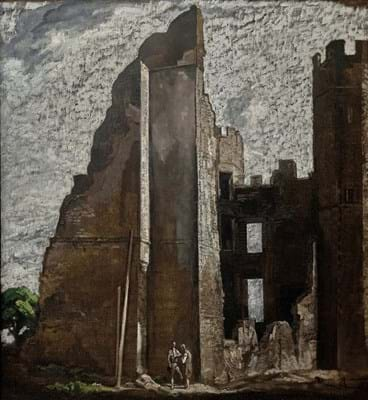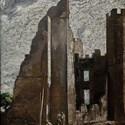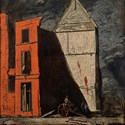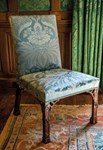Despite being lesser known today, the paintings of British artist James Pryde (1866-1941) attracted prominent buyers in his day, perhaps none so important as Baroness Annie Cowdray (1860-1932).
From 1910-22, she acted as his patroness, hanging his moody, moonlit, theatrical compositions in the library of Dunecht House in Aberdeenshire.
Now, 12 of those works are on show at Daniel Katz Gallery in Mayfair, London.
The exhibition A Quixotic Vision runs until November 1 featuring what the dealership says are Pryde’s “seminal masterpieces”, hanging together for the first time in 15 years.
All were either commissioned by Cowdray or purchased to hang in the library, itself an impressive space designed by the Victorian Gothic revival architect George Edmund Street.
It was completed in 1881 and by 1912, shortly after the Cowdrays purchased the home, the project of decorating the space with Pryde’s paintings had begun. The baroness purchased three of his works and the artist paid a visit to the home.
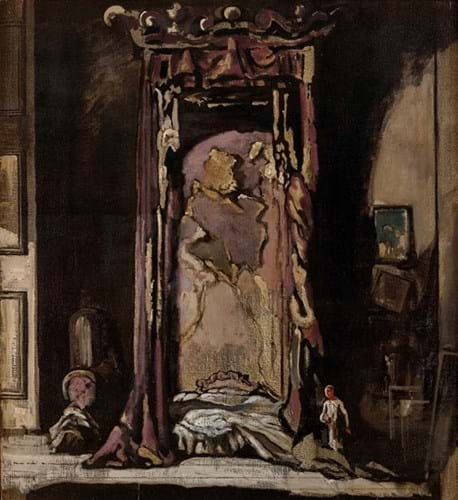
'The Derelict' (1915) by James Pryde, oil on canvas, 5ft 1in x 4ft 7in (1.54 x 1.41m). It features in the Daniel Katz Gallery exhibition.
Surprise in store
From 1998-2012 (when it was purchased) the house was unoccupied. During this period, most of Pryde’s paintings were put into storage, but Red Ruin was offered at Christie’s sale of art from the Cowdray estate in 2011 – the premium-inclusive £91,250 result remains the highest auction price for Pryde according to the Art Sales Index.
Katz acquired it from the winning bidder for £150,000 the following year. Seven years later he uncovered the rest.
Gallery director Tom Davies said: “We were in an art storage facility in 2018 looking at something else that we owned and had stored there, and his as-usual-eagle-eye caught a glimpse of something in another room. His nose told him that it was the corner of a James Pryde painting.”
After subsequent enquiries Katz managed to purchase further examples which are now on offer for £50,000-200,000 at the show. Other works from outside the collection and one loan item also feature. The dealership has collaborated on the exhibition with art historian Wendy Baron, who also wrote the introductory catalogue essay.
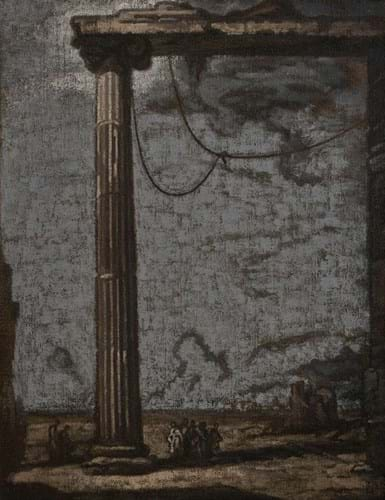
Destruction (c.1916-18) by James Pryde, oil on canvas, 3ft x 2ft 5in (92 x 74cm). It features in the Daniel Katz Gallery exhibition.
Separate style
Pryde’s career bridged the worlds of Victorian art and the early Modernism, but his works conformed to no style or movement.
In the 1890s he became one half of the graphic art and poster-design duo Beggarstaffs, which he formed with his brother-in-law William Nicholson (1872-1949).
This partnership was recently the subject of an exhibition in the Fitzwilliam Museum in Cambridge and remains his best-known artistic collaboration.
But Pryde was melancholic, solitary, prone to drink, and mostly he kept apart from artistic groups.
Though few British artists in his time worked with Abstraction, he seems to have relied mainly on historic tableaux and his imagination for subject matter. And while his renderings of ruins are ascribed sometimes to his experience of the First World War, it is possible that Old Master depictions of antique cities were a stronger influence.
The Dunecht paintings reflect Pryde’s favoured themes, which rarely varied by c.1910.
According to Baron, he gained a reputation for his renderings of bizarre townscapes – possibly inspired by his hometown of Edinburgh – defined by towering structures and diminutive, anonymous, theatrical figures.
Pryde works appear with some regularity on the UK open market and some top examples are in major British public collections.
However, the Katz show, opening during Frieze Week, could promote awareness among a wider group of international buyers.


